
By J. A. "Sam" Wilson, CET
This article completes our analysis of basic transducers. Also included is information about varactor diodes and ferrite beads [that are used often in TV receivers]. The coverage of digital-logic circuits begins next month.
Inductive Heating
As shown in Figure 1, a metal ring is placed in the field of an inductance, which has an appropriate amount of AC power applied to it. The ring acts somewhat similar to a one-turn short in the inductance winding, and a small voltage at very large current is formed in the ring. Heat in the metal ring is produced by the electron current flowing through the metal.
Inductive heating is used for welding pipes and other metallic components during fabrication.
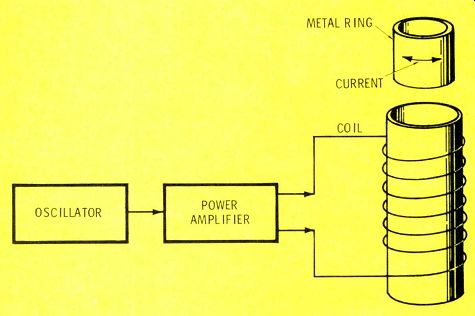
Figure 1 AC current in a metal ring placed in the field of an inductor
produces heat. The RF frequency and the amount of power applied to the
coil determines how hot the ring becomes.
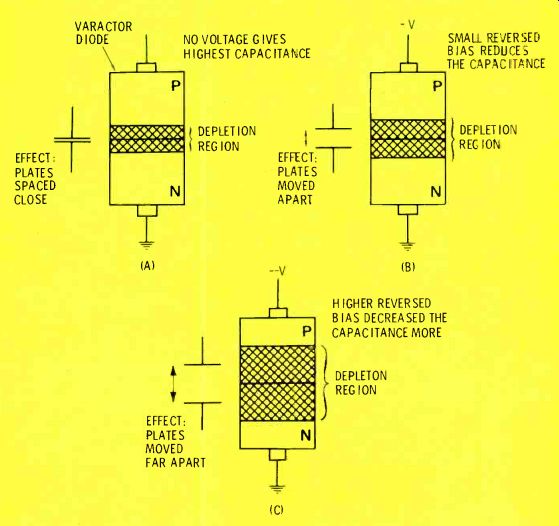
Figure 2 Reverse bias applied to a junction diode changes the size of
the depletion region, giving the effect of moving the plates of a capacitor
to produce a varying capacitance.
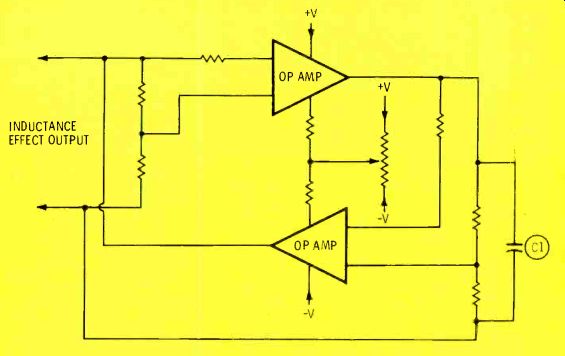
Figure 3 An inductance effect can be obtained by this circuit that uses
opamps. The advantage over discrete coils is that such gyrator circuits
can be made small enough to be included inside ICs.
Varactor Diodes-Simulated Capacitors
A diode can act as a variable capacitor when the reverse bias across it is varied. A junction diode made with N-type and P-type semi conductor materials is believed to have a depletion region near the junction, where there are few charge carriers. In other words, the depletion region acts as an insulator.
The P-type and N-type materials that are outside of the depletion region have normal concentrations of holes and electrons, so they can conduct when a voltage is present.
Therefore, the junction diode might be considered two conductors separated by an insulator. Of course, that is the definition of a capacitor, and these diodes exhibit some capacitance characteristics.
Without ally voltage applied to the diode, the depletion zone is thinnest, and the capacitance is largest, because the "capacitor" plates are near each other. (Figure 2A).
A moderate amount of reversed bias (Figure 2B) widens the depletion region, gives the effect of a wider separation of the plates, and lowers the capacitance. A higher reversed bias increases the action and the measured capacitance is reduced even more (Figure 2C).
Gyrators-Simulated Inductors
Inductors often are large and bulky when compared to capacitors and other components in semiconductor circuits. They are not suited for use inside Integrated Circuits (ICs). If they must be used with an IC, the inductor is mounted externally.
This problem of physical size can be solved by a gyrator, because gyrators can be included inside of ICs. The one in Figure 3 is made with RCA CA3060 op-amps, and the RCA manual about linear ICs states that inductance values in excess of 3,000 henries have been achieved. One drawback preventing its use above the audio range is the amount of phase shift introduced by the op-amps.
Ferrite Beads-Simulated Inductors?
Ferrite beads are small rings made of powdered iron that are usually placed over a wire (see Figure 4). The bead and wire combination acts as a small inductance. Little effect is noted from the beads except above about 50 MHz. Therefore, they are most useful when added to SCR or switching-transistor circuits, where they minimize the radiation of narrow transients (otherwise, the radiation might cause vertical lines on a TV picture, for example).
Why are the beads used instead of discrete RF chokes? It's because beads add inductance without self-resonance. In other words, an RF choke would function correctly to suppress the transient, but it might resonate with the stray capacitance of the circuit, producing a peak or valley in the response curve, which might cause ringing.
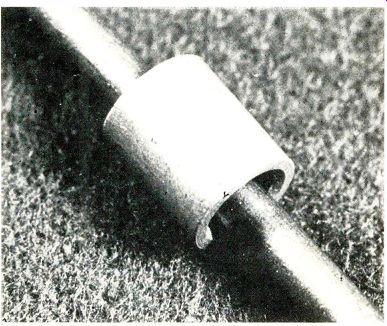
Figure 4 When placed around wire conductor, ferrite beads act as a small
inductance. The advantage over coils is that the wire and bead do not
have any self-resonance.

Figure 5 These curves show the amount of millivolts produced by each
junction of CR-CN, FE-CN, or CR-AL metals in a thermocouple.
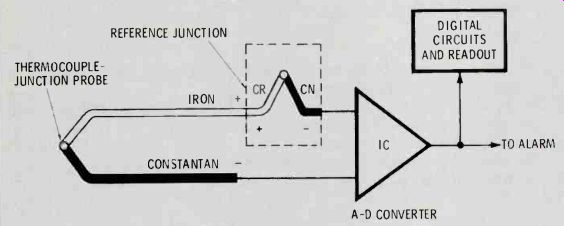
Figure 6. Accurate temperature measurements by a thermocouple device
requires a reference junction, operated at the ambient temperature, that
op poses the voltage from the measuring junction. The output can be increased
by using multiple junctions. An analog meter can be used to read the
output voltage, or (as shown) a digital circuit can activate an alarm
and show the temperature on a decimal readout.
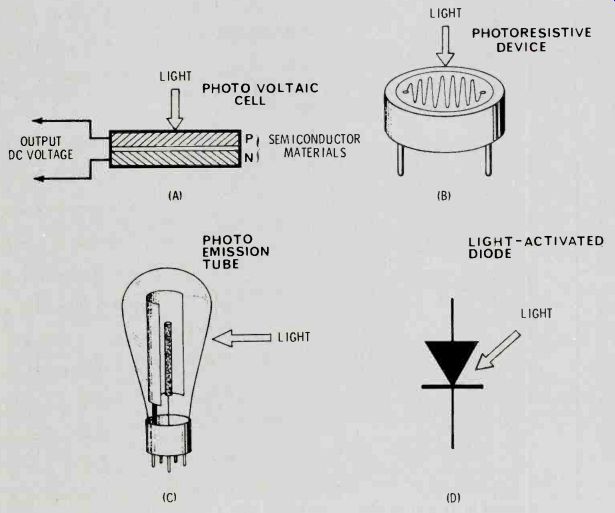
Figure
7. Here are four types of photo sensitive devices. Only (A) is an active
kind. (A) Semiconductor photovoltaic cells (photocells) emit a DC voltage
when illuminated by light. (B) Photo-resistive devices change resistance
according to the intensity of light on them. Cadmium-sulfide cells are
one common type. (C) In a photoemission tube the electron emission from
the curved surface depends on the amount of light. (D) With light-activated
di odes, the forward conduction varies according to the amount of light.
Active Transducers
Active transducers produce an output voltage that is proportional to the condition of the material being sensed.
There are six basic methods of generating a voltage. They are:
Frictional. Voltage is generated by rubbing insulating materials together. Electrostatic generators produce high-voltage low-current power;
Chemical. Voltage is produced when two dissimilar metals are immersed in an acid or alkali solution;
Thermal. When the junction of two dissimilar metals is heated, voltage is generated. Such junctions are called thermocouples;
Optical. Voltage is generated when photocells are exposed to light;
Pressure. When pressure is exerted against certain crystalline materials, voltage is produced. This is known as the piezoelectric effect;
...and...
Electromechanical. Voltage can be generated by moving a conductor through a magnetic field (or vice versa).
Chemical transducers
Except for a few applications (such as monitoring the pH factor of a liquid), chemical transducers are not often used.

Figure 8. A rotating disc with transparent sections between a light source
and the photocell can act as a digital encoder.
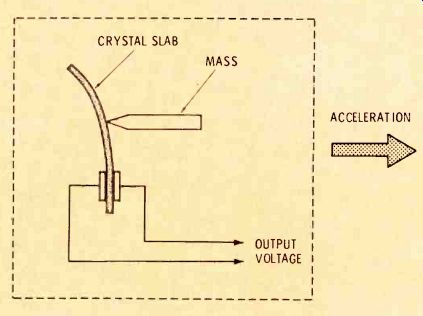
Figure 9. In an accelerometer, the signal from a crystal slab is in proportion
to the amount of acceleration applied to the standard mass.
Thermocouples
The types of metals used and the temperature at the junction deter mines the amount of voltage generated by a thermocouple. Figure 5 shows curves for different combinations of metals.
In choosing the materials for a thermocouple, the cost and the range of voltages desired are two important factors.
A thermocouple can be used to measure temperatures (Figure 6).
For accurate readings, it is necessary for the thermocouple leads to be held at a constant temperature.
The output voltage is dependent on the difference between the sensed temperature and the reference temperature.
The A/D (analog-to-digital) converter changes the thermocouple's DC output voltage to a digital signal that can be displayed on a 7-segment readout as a decimal number. If the temperature be comes excessive, and exceeds a predetermined value, the voltage comparator section of the IC activates an alarm.
A/D converters and voltage comparators will be covered in a few months when we discuss digital circuits.
Photo-transducers
Figure 7 illustrates some basic kinds of phototransducers, but only the photovoltaic cell (photocell), is an active transducer. The others are passive, and should NOT be referred to as photocells.
The simple encoder of Figure 8 uses a photocell. As the disc rotates, the photocell is alternately exposed to light and darkness. Waveform of the output voltage is determined by the pattern on the disc.
Piezoelectric transducers
A number of crystalline materials can generate a voltage when pres sure is exerted against them. How ever, only a few are useful in transducers.
One problem with many of the materials is a low Curie Point (that is, the temperature where the piezoelectric effect ceases). Other materials have a melting point that's too low for practical use.
Insensitivity is another problem with some piezoelectric materials. This means that a large force is needed to obtain only a low voltage output.
Also, many piezoelectric materials are soluble in water, so even a small amount of moisture (such as high humidity) eventually can destroy them as a generator.
After eliminating the piezoelectric materials that are not suitable for transducers, the only types remaining are quartz, ceramic crystals, and some form of barium titanate.
Quartz is a rock-like crystal found in nature. Ceramic types are made from powdered materials that are pressed into the desired shape, and then fired at high temperatures. Barium titanate was the first man-made material to be used commercially as a transducer. The precise composition of piezoelectric materials usually is a secret that's closely guarded by the manufacturer.
Piezoelectric transducers often are used for measuring a change of force or pressure, rather than for measuring a steady load. One example is the accelerometer of Figure 9. When the device is accelerated, the movable mass presses against the slab of crystal line material. The voltage output comes from terminals attached to the crystal, and the voltage is proportional to the amount of acceleration.
Incidentally, don't use the terms stress and strain interchangeably if you use them to describe equipment such as an accelerometer. Stress is the amount of force exerted, and strain is the change of shape that results from the stress.
Electromechanical transducers
When there is a relative motion between a conductor and a magnetic field, a voltage is induced in the conductor. This is a statement of Faraday's Law, and it's the principle behind electromagnetic transducers.
Think of these transducers as generators of either AC or DC power. The frequency or DC output voltage is a direct function of the rate of the shaft rotation of the amount they are turned.
A tachometer is one good example of a electromechanical transducer. It's used to sense the speed of a motor. One method incorporating a closed loop is shown in Figure 10.
One important characteristic of a synchronous motor is that the speed varies precisely in step with the frequency of the supply voltage.
That's why synch motors are used in electric clocks.

Figure 10. One type of speed control for a synchronous motor uses a closed-loop,
and compares the tachometer reading of the motor speed against the reference
frequency.
Varying the frequency of the motor voltage changes the motor speed.
The output of the tachometer has a frequency determined by the speed of the motor. This signal is one input of a frequency comparator, while a reference frequency is the other input signal.
If the two input signals have exactly the same frequency, no correction voltage is developed.
When the motor speed (and the tachometer frequency) is too fast or too slow, the frequency comparator produces a DC correction voltage that controls the amount of reverse bias at the varactor diode. This diode is part of the LC circuit that determines the oscillator frequency; therefore, the correction voltage changes the frequency, making the synchronous motor run faster or slower, as required, until the tacho meter and the reference frequency are identical.
A similar closed-loop arrangement also can be used to control the speed of a DC motor (Figure 11). In this case, the output of the tachometer is a DC voltage that varies directly with the motor speed. The tachometer DC voltage and the reference DC voltage are r examined by the comparator circuit. When the motor speed is incorrect, the comparator control voltage changes the DC voltage coming from the power supply.
This voltage usually is applied to both the armature and the field of the motor; however, some types of DC motors are designed to be controlled by the armature voltage, while the field voltage remains constant.

Figure 11. A speed control for a DC motor is similar to the one in Figure
10, except the reference and sensor signals are DC, the comparator works
from those DC voltages, and the motor speed is changed by varying the
applied DC voltage.
Next Month:
Many industrial functions and processes must be monitored and controlled to keep them within the range of specifications. Corrections can't be made properly without a knowledge of the conditions at all times. That's the function of transducers, because they can sense speed, pressure, position, intensity of light, heat, color, and a variety of other characteristics.
If we compare a control system to a human, the transducers are the equivalent of eyes, ears, and fingers.
A logic system is like the brain. Of course, this analogy is not perfect, because no logic system can reason.
Instead, it reacts to simple pro grams that already are stored in the system. Therefore, in the next issue, we will begin an in-depth study of logic circuitry.
(adapted from: Electronic Servicing magazine, Dec. 1977)
Also see: The Basics of Industrial Electronics, Part 7
The Basics of Industrial Electronics, Part 1 (Jun. 1977)